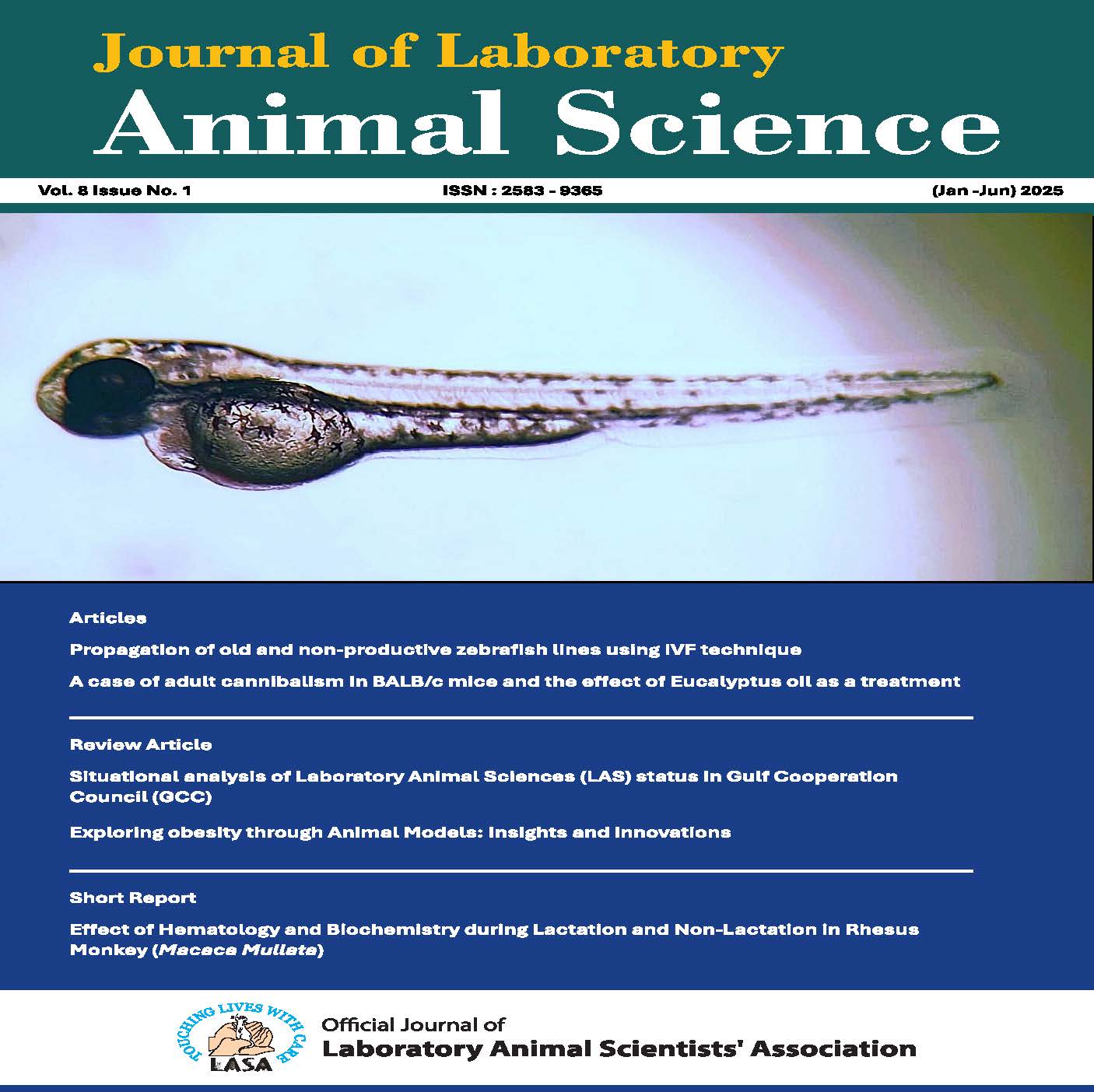Zingerone reduces muscle pain by modulating the PGE2 Pathway
DOI:
https://doi.org/10.48165/jlas.2026.9.1.3Keywords:
Chronic muscle inflammation, pain modulation, in vitro, Zingerone, in vivo, Molecular dockingAbstract
Chronic inflammatory muscle pain represents a significant clinical challenge with limited therapeutic options. This study investigates the modulatory effects of zingerone, a bioactive compound derived from ginger (Zingiber officinale), on prostaglandin E2 (PGE2) signaling pathways in the chronic myalgia model. Using an integrated approach combining in vivo, in vitro, and in silico analyses, we demonstrate that zingerone significantly attenuates inflammatory muscle pain. In vivo studies using carrageenan-induced muscle inflammation in rats showed a substantial reduction in pain behaviors and inflammatory markers following zingerone administration (20-40 mg/kg). In vitro experiments revealed zinge rone’s inhibitory effects on PGE2 production in a dose-dependent manner. Molecular docking simulations identified key binding interactions between zingerone and the PGE2, cyclooxygenase-2 (COX-2) enzyme active site, with a predicted binding affinity of -4.8 and -6.4 kcal/mol, respectively. Zingerone treatment significantly modulated the PGE2/COX-2 signaling pathway, further supporting its anti-inflammatory properties. These findings suggest that zingerone represents a promising natural therapeutic agent for chronic inflammatory muscle pain conditions through its targeted inhibition of PGE2-mediated inflammatory cascades.
Downloads
References
Ahmad, B., Rehman, M. U., Amin, I., Arif, A., Rasool, S., Bhat, S. A., Afzal, I., Hussain, I., Bilal, S., & Mir, M. U. R. (2015). A review on pharmacological properties of zingerone (4-(4-hydroxy-3-methoxyphenyl)-2-butanone). Scientific World Journal, 2015, 816364.
Chopade et al. (2026). Zingerone reduces muscle pain by modulating the PGE2 pathway. Journal of Laboratory Animal Science, 9(1), 32.
Alam, M. F., Hijri, S. I., Alshahrani, S., Alqahtani, S. S., Jali, A. M., Ahmed, R. A., Adawi, M. M., Algassmi, S. M., Shaheen, E. S., Moni, S. S., & Anwer, T. (2022). Zingerone attenuates carfilzomib-induced cardiotoxicity in rats through oxidative stress and inflammatory cytokine network. International Journal of Molecular Sciences, 23(24), 15617.
Ayustaningwarno, F., Anjani, G., Ayu, A. M., & Fogliano, V. (2024). A critical review of ginger’s (Zingiber officinale) antioxidant, anti-inflammatory, and immunomodulatory activities. Frontiers in Nutrition, 11, 1364836.
Ballester, P., Cerdá, B., Arcusa, R., Marhuenda, J., Yamedjeu, K., & Zafrilla, P. (2022). Effect of ginger on inflammatory diseases. Molecules, 27(21), 7223.
Bashir, N., Ahmad, S. B., Rehman, M. U., Muzamil, S., Bhat, R. R., Mir, M. U. R., Shazly, G. A., Ibrahim, M. A., Elossaily, G. M., Sherif, A. Y., & Kazi, M. (2021). Zingerone (4-(four-hydroxy-3-methylphenyl) butane-two-1) modulates adjuvant-induced rheumatoid arthritis by regulating inflammatory cytokines and antioxidants. Redox Report, 26(1), 62–70.
Chopade, A. R., Patil, P. A., & Mali, S. N. (2020). Pharmacological aspects of standardized extract (rich in lignans and tannins) as a pain modulator. The Open Pain Journal, 13, 22–34.
El-Tallawy, S. N., Nalamasu, R., Salem, G. I., LeQuang, J. A. K., Pergolizzi, J. V., & Christo, P. J. (2021). Management of musculoskeletal pain: An update with emphasis on chronic musculoskeletal pain. Pain and Therapy, 10(1), 181–209.
Ju, Z., Li, M., Xu, J., Howell, D. C., Li, Z., & Chen, F. E. (2022). Recent development on COX-2 inhibitors as promising anti-inflammatory agents: The past 10 years. Acta Pharmaceutica Sinica B, 12(6), 2790–2807.
Karcz, M., Abd-Elsayed, A., Chakravarthy, K., Aman, M. M., Strand, N., Malinowski, M. N., Latif, U., Dickerson, D., Suvar, T., Lubenow, T., Peskin, E., D’Souza, R., Cornidez, E., Dudas, A., Lam, C., Farrell, M., II, Sim, G. Y., Sebai, M., Garcia, R., ... Deer, T. (2024). Pathophysiology of pain and mechanisms of neuromodulation: A narrative review (a neuron project). Journal of Pain Research, 17, 3757–3790.
Khairy, A., Ghareeb, D. A., Celik, I., Hammoda, H. M., Zaatout, H. H., & Ibrahim, R. S. (2023). Forecasting potential anti-inflammatory targets of immunomodulatory plants using in vitro, molecular docking, and network pharmacology-based analysis. Scientific Reports, 13, 9539.
Matin, M., Koszarska, M., Atanasov, A. G., Król-Szmajda, K., Jóźwik, A., Stelmasiak, A., & Hejna, M. (2024). Bioactive potential of algae and algae-derived compounds: Focus on anti-inflammatory, antimicrobial, and antioxidant effects. Molecules, 29(19), 4695.
Nakadate, K., Ito, N., Kawakami, K., & Yamazaki, N. (2025). Anti-inflammatory actions of plant-derived compounds and prevention of chronic diseases: From molecular mechanisms to applications. International Journal of Molecular Sciences, 26(11), 5206.
Olasehinde, T. A., & Olaokun, O. O. (2025). Zingerone as a neuroprotective agent against cognitive disorders: A systematic review of preclinical studies. International Journal of Molecular Sciences, 26(13), 6111.
Ozkur, M., Benlier, N., Takan, I., Vasileiou, C., Georgakilas, A. G., Pavlopoulou, A., Cetin, Z., & Saygili, E. I. (2022). Ginger for healthy ageing: A systematic review on its antioxidant, anti-inflammatory, and anticancer properties. Oxidative Medicine and Cellular Longevity, 2022, 4748447.
Pázmándi, K., Szöllősi, A. G., & Fekete, T. (2024). The “root” causes behind the anti-inflammatory actions of ginger compounds in immune cells. Frontiers in Immunology, 15, 1400956.
Radu, A., Tit, D. M., Endres, L. M., Radu, A. F., Vesa, C. M., & Bungau, S. G. (2025). Naturally derived bioactive compounds as precision modulators of immune and inflammatory mechanisms in psoriatic conditions. Inflammopharmacology, 33(2), 527–549.
Song, Q., E, S., Zhang, Z., & Liang, Y. (2024). Neuroplasticity in the transition from acute to chronic pain. Neurotherapeutics, 21(6), e00464.
Song, Y., Ni, J., Yuan, J., Zhang, Z., Wang, D., & Xiong, Z. (2025). Effects of low-frequency and high-frequency electroacupuncture pretreatment on the COX-2/mPGES-1/PGE2 pathway in a rat model of cold-coagulation dysmenorrhea. Frontiers in Immunology, 16, 1563626.
Watkins, S. L. (2023). Current trends in membrane molecular dynamics simulations in academia and the pharmaceutical industry. Membranes, 13(2), 148.
Wei, D., Birla, H., Dou, Y., Mei, Y., Huo, X., Whitehead, V., Osei-Owusu, P., Feske, S., Patafio, G., Tao, Y., & Hu, H. (2024). PGE2 potentiates Orai1-mediated calcium entry contributing to peripheral sensitization. Journal of Neuroscience, 44(1), e0329232023.

